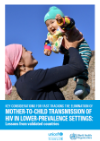Publications - Released in 2023
Over more than a decade, the world has made considerable progress in reaching women with services to reduce vertical transmission of HIV. Most countries have adopted lifelong ART to “treat all” pregnant women, regardless of their CD4 count, as part of a public health approach and one of the key objectives to achieve the elimination of mother-to-child transmission (EMTCT) of HIV. Yet, results of efforts to reduce the number of new paediatric HIV infections have fallen short against the 2020 Start Free target, among others; the goal of ending HIV and AIDS in children remains elusive.
This key considerations document expands on the 2020 “last mile” operational guidance, with specific considerations for countries with lower HIV prevalence. It builds on the experiences of countries that have been validated for EMTCT of HIV and syphilis and translates the valuable lessons and promising practices of these countries into an operational framework for national programmes, consisting of 12 strategies and enablers to guide efforts towards Fast-Tracking EMTCT in lower prevalence countries.
Downloads
Organizations
- World Health Organization (WHO)
- United Nations Children’s Fund (UNICEF)






